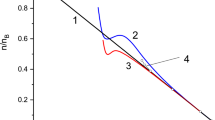Abstract
The virial theorem is considered for a system of randomly moving particles that are tightly bound to each other by the gravitational and electromagnetic fields, acceleration field and pressure field. The kinetic energy of the particles of this system is estimated by three methods, and the ratio of the kinetic energy to the absolute value of the energy of forces, binding the particles, is determined, which is approximately equal to 0.6. For simple systems in classical mechanics, this ratio equals 0.5. The difference between these ratios arises by the consideration of the pressure field and acceleration field inside the bodies, which make additional contribution to the acceleration of the particles. It is found that the total time derivative of the system’s virial is not equal to zero, as is assumed in classical mechanics for systems with potential fields. This is due to the fact that although the partial time derivative of the virial for stationary systems tends to zero, but in real bodies the virial also depends on the coordinates and the convective derivative of the virial, as part of the total time derivative inside the body, is not equal to zero. It is shown that the convective derivative is also necessary for correct description of the equations of motion of particles.
Similar content being viewed by others
References
Saslaw, W.C.: Gravitational Physics of Stellar and Galactic Systems. Cambridge University Press, Cambridge (1985)
Schmidt, G.: Physics of High Temperature Plasmas, 2nd edn., p. 72. Academic Press, New York (1979)
Ganghoffer, J.F.: On the generalized virial theorem and Eshelby tensors. Int. J. Solids Struct. 47(9), 1209–1220 (2010). doi:10.1016/j.ijsolstr.2010.01.009
Ganghoffer, J., Rahouadj, R.: On the generalized virial theorem for systems with variable mass. Contin. Mech. Thermodyn. 28(1), 443–463 (2016). doi:10.1007/s00161-015-0444-3
Fedosin, S.G.: About the cosmological constant, acceleration field, pressure field and energy. Jordan J. Phys. 9(1), 1–30. http://journals.yu.edu.jo/jjp/Vol9No1Contents2016.html, http://journals.yu.edu.jo/jjp/JJPIssues/Vol9No1pdf2016/1.pdf (2016)
Fedosin, S.G.: The procedure of finding the stress–energy tensor and vector field equations of any form. Adv. Stud. Theor. Phys. 8, 771–779 (2014). doi:10.12988/astp.2014.47101
Fedosin, S.G.: The concept of the general force vector field. OALib J. 3, 1–15 (2016). doi:10.4236/oalib.1102459
Fedosin, S.G.: The integral energy-momentum 4-vector and analysis of 4/3 problem based on the pressure field and acceleration field. Am. J. Mod. Phys. 3(4), 152–167 (2014). doi:10.11648/j.ajmp.20140304.12
Heaviside, O.: On the electromagnetic effects due to the motion of electrification through a dielectric. Philos. Mag. 27(167), 324–339 (1889)
Fedosin, S.G.: Estimation of the physical parameters of planets and stars in the gravitational equilibrium model. Can. J. Phys. 94(4), 370–379 (2016). doi:10.1139/cjp-2015-0593
Clemens, D.P., Yun, J.L., Meyer, M.H.: BOK globules and small molecular clouds—deep IRAS photometry and \({}^{12}\text{CO}\) spectroscopy. Astrophys. J. Suppl. 75, 877–904 (1991). doi:10.1086/191552
Fedosin, S.G.: Relativistic energy and mass in the weak field limit. Jordan J. Phys. 8(1), 1–16 (2015)
Author information
Authors and Affiliations
Corresponding author
Additional information
Communicated by Andreas Öchsner.
Rights and permissions
About this article
Cite this article
Fedosin, S.G. The virial theorem and the kinetic energy of particles of a macroscopic system in the general field concept. Continuum Mech. Thermodyn. 29, 361–371 (2017). https://doi.org/10.1007/s00161-016-0536-8
Received:
Accepted:
Published:
Issue Date:
DOI: https://doi.org/10.1007/s00161-016-0536-8



